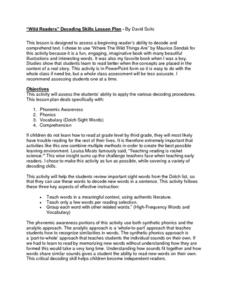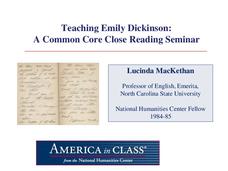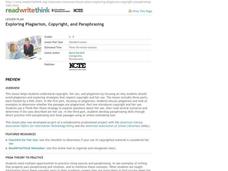David Suits
“Wild Readers” Decoding Skills Lesson Plan
Set young readers on the path toward fluency with this phonemic awareness resource. Based on the award-winning children's book, Where the Wild Things Are, this lesson allows beginning readers to practice isolating...
Curated OER
Vocabulary and Concept Development
Considering a lesson on Greek and Latin roots and affixes? The Latin roots bas and pos, and the Greek root bas are the focus on a colorful, animated presentation that will engage your learners and provide guided and independent practice...
All-in-One High School
Elements of Plot
Cinderella wants to go to the ball and marry the prince. At the end of the story, she does! But how does the plot move from the exposition to the resolution? Teach language arts learners and fairy tale fans about the basics of plot...
Curated OER
Dramatic Structure
As part of an lesson involving literature or writing, have your learners watch and discuss this presentation on plot development. In a series of slides, viewers engage in an activity to explore dramatic structure, including plot...
Curated OER
Lesson 12: What Reasonable Conclusions are Possible?
Oftentimes, we jump to conclusions when we are given a limited amount of information. Take a look at reasonable conclusions with your communications studies class. If-clauses, dichotomous thinking, and assumptions are all covered with...
Curated OER
Characterization
A 46-slide presentation focuses on ways to describe characters in stories, how to create story characters, and how to show a character's personality in a student-created story. The colorful and engaging slides provide lots of great ideas...
National Humanities Center
Teaching Emily Dickinson: A Common Core Close Reading Seminar
Three of Emily Dickinson's poems, "I like to see it," "Because I could not stop for Death," and "We grow accustomed to the Dark," provide instructors with an opportunity to model for class members how to use close reading strategies to...
Orange County Schools
Piggybook
Summarizing text is a balancing act between being brief but thorough. You need to be short and to the point, but also cover all the important details, a task that presents a challenge for many young learners. In this lesson based on the...
ReadWriteThink
Exploring Plagiarism, Copyright, and Paraphrasing
Plagiarism, copyright, and fair use are the focus of a three-part instructional activity designed to inform scholars of how to properly cite others' work. First, pupils use a KWL chart to begin thinking and...
Curated OER
Spanish Prepositional Pronouns
There are many different types of pronouns used in Spanish for various purposes. If your class has mastered subject pronouns, object pronouns, and reflexive pronouns, perhaps they are ready to learn about prepositional pronouns. You can...
Curated OER
Parts of a Friendly Letter
The art of writing a letter has not been lost to email and texting! Teach kids how to format a friendly letter with a presentation about the parts of a letter, as well as prompting them to write a letter about their favorite holiday.
Kenan Fellows
Determining Stream Health by the Diversity and Types of Benthic Organisms
How diverse are the benthic organisms found in local streams? Using the information learned in previous lessons on identification of macroinvertebrates and on calculating stream index values, groups determine the health of local...
Tompson Solutions
Be a Reporter (The 5 W's and an H)
Teach your class how to investigate research sources. You can start out with this presentation, which lays out a easy strategy for asking questions and taking down answers that cover the important information.
Curated OER
Time Expressions with Hacer
The verb hacer has many purposes in the Spanish language, one of which is as part of time expressions. Your class can learn how to use hacer in the preterite, present perfect continuous, and past perfect continuous to express different...
Curated OER
Los Verbos Regulares: -ar verbs
Learn how to conjugate -ar Spanish verbs with this colorful PowerPoint. Viewers will see examples of different regular verbs conjugated properly, practice choosing the correct forms, as well as translate twelve sentences from English to...
Curated OER
Feudal Japan
An excellent overview of historical Japanese culture, this presentation could carry through a world history unit or a lesson on the history of Japan. Especially interesting are the slides that compare Japanese armor and castles to other...
Curated OER
Clash of Cultures and Marching North
Each of the 23 slides that comprise this presentation are intended to enhance or support lessons on shifts in religion and the colonization of the Americas. Students are guided through the changes in religion that ultimately lead to the...
Curated OER
The Amazing World of Dictionaries
Use this resource to discuss various ways to dictionaries can be used. What a terrific presentation to display when exploring how dictionaries are used to define words, check spellings, identify parts of speech, and more. The PowerPoint...
Weebly
Los Verbos Regulares
¿Qué haces ahora? Conjugate common Spanish verbs with a slideshow presentation that focuses on the present tense. As Spanish learners review personal pronouns and the parts of a verb, they work on forming the present tense with...
Curated OER
Visible Speech: A Short Course in the Fundamentals of Writing
Use this presentation to introduce a class or lecture about writing organization. The slide show is the first part in a five-part series, titled "What is an Essay?" The slideshow is short and could use more detail, but functions as a...
Curated OER
Identifying Terms, Factors, and Coefficients
What are terms, factors, and coefficients? This slideshow provides definitions and examples of various parts of algebraic expressions, and provides guided practice problems in writing and identifying parts of algebraic expressions for...
Kenan Fellows
Using Water Chemistry as an Indicator of Stream Health
Will this water source support life? Small groups test the chemistry of the water drawn from two different sources. They then compare the collected data to acceptable levels to draw conclusions about the health of the source. The...
Sophia Learning
Sophia: Clarity: Avoiding Assumptions
This lesson discusses avoiding assumptions about the reader. CCSS.ELA-Literacy.WHST.6-8.4
























